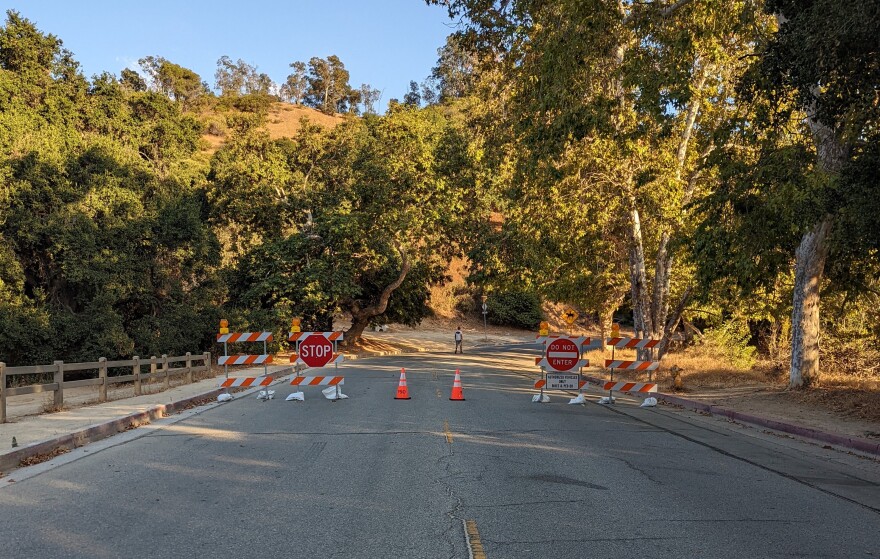Truth matters. Community matters. Your support makes both possible. LAist is one of the few places where news remains independent and free from political and corporate influence. Stand up for truth and for LAist. Make your year-end tax-deductible gift now.
Why Cars Are Now Banned From A Section Of Griffith Park

Griffith Park is a popular public space for Angelenos but it doesn’t always feel safe or welcoming. Thanks, in large part, to drivers who use the park's roads as a shortcut to avoid traffic on the adjacent 5 and 134 freeways.
Now an experiment is underway to reimagine what the park would be like with less car traffic. Starting this week, cars are banned on Griffith Park Drive from the Travel Town Museum to Mt. Hollywood Drive.
It’s the first step in a multi-phase project aimed at making the popular public space safer and more accessible for people walking, biking and riding horses.
The car ban comes a couple months after Andrew Jelmert, 77, was struck and killed by a driver while biking on Crystal Springs Drive. The driver fled the scene but was later arrested and charged with murder. Authorities allege he was driving drunk through the park when he struck Jelmert, who was training for an upcoming charity ride.
Event aims to "celebrate freedom" on Griffith Park Drive
Saturday, July 2: Community safety advocates are inviting the public to come out and enjoy the section of Griffith Park now off-limits to cars. Cyclists, walkers, runners and hikers will be gathering near Travel Town (close to the intersection of Zoo Drive and Griffith Park Drive) at 8 a.m. The mass trip along the route is set to start at 9 a.m.
After his death, cyclists and safety advocates called on the city to make the park safer and limit access to drivers of vehicles.
City Councilmember Nithya Raman said her office was already exploring ways to improve safety and reduce car traffic in the park, but Jelmert’s “sudden and incredibly tragic death… really made this an intervention with real urgency behind it.”
L.A.’s Department of Recreation and Parks has sole jurisdiction over the roads, making upgrades easier, she noted.
“There may be some things that require council approval, but there's a lot of departmental and council office leeway here that enables us to move forward,” she said.
Temporary Ban — For Now

The car ban is temporary, but indefinite, Raman said. At the same time, city officials are exploring long-term safety upgrades for about five miles of park road along Griffith Park Drive and Crystal Springs Drive.
The parks department hired a consulting firm to study traffic patterns, conduct speed surveys and observe conditions on the roads. They reported notable cut-through traffic, with drivers frequently traveling over the posted speed limit of 25 mph. The study also notes wide lanes and “conflict areas” — places where car drivers, cyclists and pedestrians interact on the roads — that increase the risk of dangerous or fatal collisions.
The consultants noted the lack of protected bike space in the park, saying it’s mostly “strong and fearless” cyclists that feel comfortable enough to ride in present conditions.
Some other safety concerns listed in the study:
- Not enough bicycle-related signage and road striping
- “Poor connections” to nearby bike lanes
- Limited visibility for drivers as they approach crosswalks
- Not enough “traffic calming devices” (aka lights to alert drivers) at crosswalks
- No paved pedestrian infrastructure on Crystal Springs Drive
- Poor quality and faded traffic signage
Next Steps
So what’s next? Raman said the goal is for consultants to present “a set of options that will give us those short-term measures that are quick and dirty, that can get us to some immediate improvements in safety.”
Longer-term measures “may require a little bit more community input” and potentially additional funding, she noted.
A slate of possible safety countermeasures listed in the project presentation recently made to the Griffith Park Advisory Board include:
- Speed feedback signs
- Raised crosswalks
- Narrowing and reducing vehicle lanes
- Adding protected bike lanes
- Limiting on-street parking
- Restricting car access to the park on cut-through points during peak freeway hours
- Banning cars from the upper section of Crystal Spring Drive
- Improving bus stops to promote more public transit to the park
Raman hopes all that work can get done “in about a year.”
“We have a lot of potential in the streets that are within Griffith Park and outside of Griffith Park to think about interventions that can really protect users of these spaces who are walking, who are riding horses or bicycles, and really make it a safe place for everyone,” she said.
Alex Rodgers lives near the park and cycles there several times a week. He celebrated the car ban, saying riding Griffith Park Drive this week “finally felt like a safe park road.”
“I even saw families walking on it for the first time,” he told LAist. “I’d consider that an instant sign of success.”
Rodgers also wants to see more changes “to make Griffith function less like a highway and more like a park.” He added:
“For years, we’ve had to share the road with speeding drivers trying to use the park as a shortcut to and from the 5 and 134 [freeways]. Danger is an element that we’ve been forced to expect as cyclists on most L.A. roads, but one that we shouldn’t have to face in a park.”
Updated July 1, 2022 at 12:58 PM PDT
This story was updated to include information about a community event planned to celebrate the car-free section of Griffith Park Drive.







